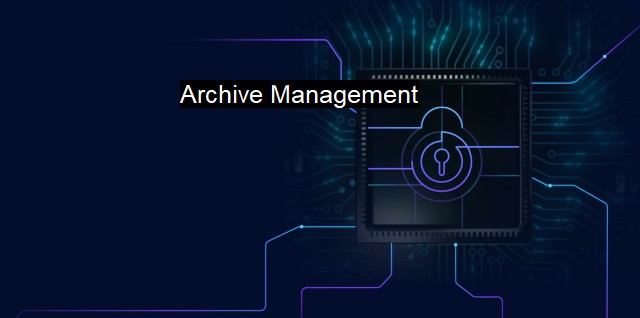What is Archive Management?
The Importance of Archive Management in Cybersecurity: Secure Your Critical Information and Avoid Catastrophic Breaches
Archive management, with refers to the systematic process of protecting, categorizing, and storing digital data files to allow for effective backup, recovery, and security. These archived assets can consist of emails, documents, databases, multimedia files, reports, logs, or any other type of valuable, confidential, or sensitive information. With the constant threat of cyber-attacks, data breaches, ransomware, and other malicious online activities aimed at accessing, corrupting, or destroying this critical information, archive management has become vital to both cybersecurity and antivirus strategies.As organizations generate, use, and keep vast amounts of data every day, it’s essential to have a management system in place that can effectively archive this data, to not only ensure its efficient retrieval when necessary but also to protect it from various cyber threats. This means that, alongside its traditional time and resource-saving advantages, archive management has now become a pivotal pillar in cyber defense mechanisms and risk reduction strategies.
Cybersecurity-oriented archive management involves multiple protective measures. it demands the creation of secure backup duplicates, stored separately from the main system. In case the primary documents are corrupted after a cyber-attack, organizations can easily retrieve an unaffected version from the backups. robust encryption techniques can secure hashed archives to safeguard them from interception during transportation or storage. Such encryption can transform them into unreadable data for anyone without the keys necessary for decryption.
An additional practical safeguarding method is the application of restrictive access and authentification systems. This ensures only specific, authorized personnel can access the archives, and that every interaction is properly logged. Consequently, not only does this step prevent unauthorized access or misuse, but it can also aid in identifying potential security issues and their roots, thereby promoting proactive rather than reactive security.
Within antivirus strategies, archive management contributes by providing a fallback in case a dangerous virus causes mayhem in the system. antivirus software often inspects archives for potential threats as for various malware types, archives serve as perfect hiding grounds. Since archives contain inactive data, it’s easy for viruses to go unnoticed until these data are extracted and used. Therefore, routinely scanning these archives has become an indispensable element of thorough antivirus strategies. antivirus software with archive management features helps in automating this process.
The reliability and efficiency of these strategies depend mostly on the implemented archive management tools, requiring that the chosen software be aptly equipped to address an organization's specific needs. Some organizations might require simple features for archiving relatively small databases, whereas others, such as multinational corporations with massive amounts of data distributed across several locations and systems, might need multipart schemes that include automation features, advanced threat detections, and integration capacity with existing security systems.
For a comprehensive archive management system to manifest its full potential it must be combined with other security practices. Employee training, for instance, is crucial to minimizing the risk of phishing and other scams. Regular audits can identify any weaknesses in the archive management system while continuous system and software updates will ensure the best resilience against evolving cyber threats.
Archive management is a multi-faceted discipline in the realm of cybersecurity and antivirus. It handles a dual function – facilitating the effective organization of digital information, making it quickly accessible and secure, and empowering robust defenses against a multitude of cyber threats. For these reasons, it’s one of those silent undercurrents that shape the landscape of our digital world steadfastly and surely.

Archive Management FAQs
What is archive management in the context of cybersecurity and antivirus?
Archive management refers to the process of managing and organizing digital archives, which contain important information and data. In the context of cybersecurity and antivirus, archive management is critical for ensuring that valuable data is kept safe and secured from cyber threats such as viruses, malware, and ransomware.What are the benefits of archive management for cybersecurity and antivirus?
There are several benefits of archive management for cybersecurity and antivirus. It helps to protect against data loss, ensures compliance with data privacy laws, improves data accuracy and accessibility, and provides a central location for data storage and management. Archive management also makes it easier to detect and respond to security threats and enables better collaboration and sharing of information among employees.What are some best practices for archive management in cybersecurity and antivirus?
Some best practices for archive management in cybersecurity and antivirus include implementing strong password policies, regularly backing up important data, encrypting sensitive information, limiting access to data based on need-to-know, and properly disposing of outdated or unnecessary data. It is also important to perform regular vulnerability scans and updates, and to establish a disaster recovery plan in case of a security breach or system failure.What role do antivirus software and tools play in archive management for cybersecurity?
Antivirus software and tools are critical components of archive management for cybersecurity. They help to detect and remove viruses and malware from digital archives, prevent unauthorized access to sensitive data, and provide real-time protection against security threats. Antivirus software and tools also enable organizations to monitor archive activity, identify potential security risks, and implement necessary security updates and patches.| | A | | | B | | | C | | | D | | | E | | | F | | | G | | | H | | | I | | | J | | | K | | | L | | | M | |
| | N | | | O | | | P | | | Q | | | R | | | S | | | T | | | U | | | V | | | W | | | X | | | Y | | | Z | |
| | 1 | | | 2 | | | 3 | | | 4 | | | 7 | | | 8 | | |||||||